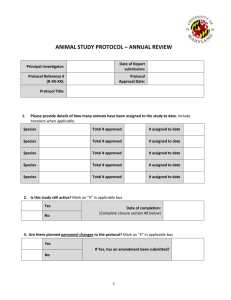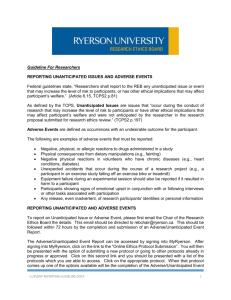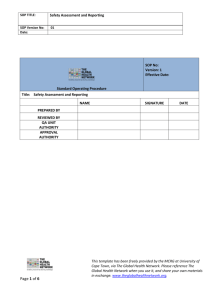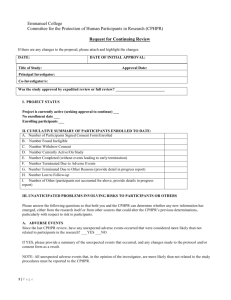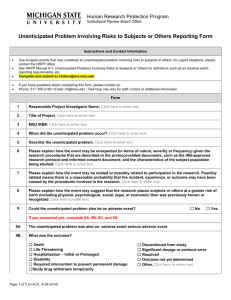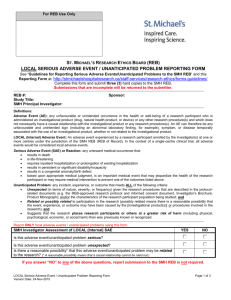SOP 005 - Safety Reporting Requirements for Research Involving
advertisement
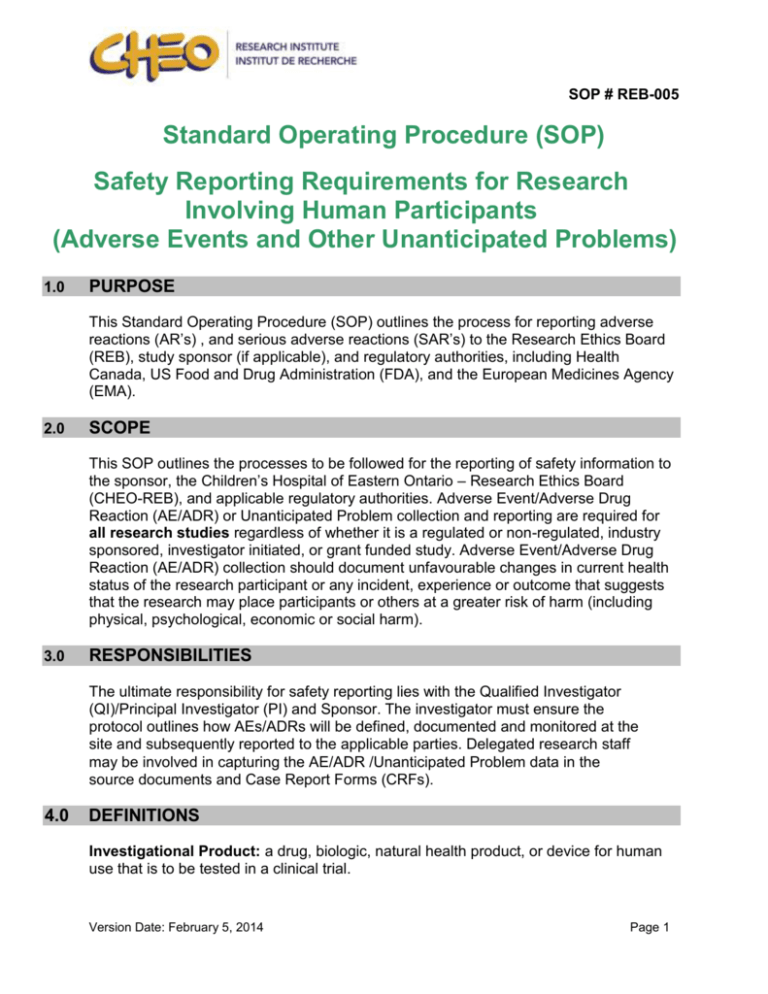
SOP # REB-005 Standard Operating Procedure (SOP) Safety Reporting Requirements for Research Involving Human Participants (Adverse Events and Other Unanticipated Problems) 1.0 PURPOSE This Standard Operating Procedure (SOP) outlines the process for reporting adverse reactions (AR’s) , and serious adverse reactions (SAR’s) to the Research Ethics Board (REB), study sponsor (if applicable), and regulatory authorities, including Health Canada, US Food and Drug Administration (FDA), and the European Medicines Agency (EMA). 2.0 SCOPE This SOP outlines the processes to be followed for the reporting of safety information to the sponsor, the Children’s Hospital of Eastern Ontario – Research Ethics Board (CHEO-REB), and applicable regulatory authorities. Adverse Event/Adverse Drug Reaction (AE/ADR) or Unanticipated Problem collection and reporting are required for all research studies regardless of whether it is a regulated or non-regulated, industry sponsored, investigator initiated, or grant funded study. Adverse Event/Adverse Drug Reaction (AE/ADR) collection should document unfavourable changes in current health status of the research participant or any incident, experience or outcome that suggests that the research may place participants or others at a greater risk of harm (including physical, psychological, economic or social harm). 3.0 RESPONSIBILITIES The ultimate responsibility for safety reporting lies with the Qualified Investigator (QI)/Principal Investigator (PI) and Sponsor. The investigator must ensure the protocol outlines how AEs/ADRs will be defined, documented and monitored at the site and subsequently reported to the applicable parties. Delegated research staff may be involved in capturing the AE/ADR /Unanticipated Problem data in the source documents and Case Report Forms (CRFs). 4.0 DEFINITIONS Investigational Product: a drug, biologic, natural health product, or device for human use that is to be tested in a clinical trial. Version Date: February 5, 2014 Page 1 SOP # REB-005 Adverse Event (AE): any untoward medical occurrence in a research participant administered an investigational product and which does not necessarily have a causal relationship with this product. An AE can therefore be any unfavourable and unintended sign (including an abnormal laboratory finding, for example), symptom, or disease temporally associated with the use of an investigational product, whether or not related to the investigational product. External adverse event: From the perspective of the Research Ethics Board (REB) overseeing one or more centres engaged in a multi-centre research study, external adverse events are those adverse events experienced by research participants enrolled by investigator(s) at other centres/institutions outside the REB’s jurisdiction. Local (Internal) adverse event: local adverse events are those adverse events experienced by research participants enrolled by the investigator(s) at one or more centres under the jurisdiction of the REB of Record. In the context of a single-centre research study, all adverse events would be considered local adverse events. Adverse Drug Reaction (ADR): all noxious and unintended responses to an investigational product related to any dose should be considered adverse drug reactions. The phrase responses to an investigational product means that a causal relationship between the investigational product and an adverse event is at least a reasonable possibility (i.e., the relationship cannot be ruled out). Unexpected Adverse Drug Reaction: an adverse reaction, the nature or severity of which is not consistent with the applicable product information (e.g. the Investigator’s Brochure for an unapproved investigational product or the Product Monograph for an approved drug). Reports which add significant information on specificity or severity of a known, already documented serious ADR constitute unexpected events. For example, an event more specific or more severe than described in the Investigator's Brochure would be considered "unexpected". Specific examples would be (a) acute renal failure as a labeled ADR with a subsequent new report of interstitial nephritis and (b) hepatitis with a first report of fulminant hepatitis. Unanticipated Problem: any incident, experience, or outcome that meets all of the following criteria: Unexpected (in terms of nature, severity, or frequency) given (a) the research procedures that are described in the protocol-related documents, such as the REB-approved research protocol and informed consent document, or the Investigator Brochure (IB) or product monograph (PM); and (b) the characteristics of the research participant population being studied; and Related or possibly related to participation in the research (possibly related means there is a reasonable possibility that the incident, experience, or outcome Version Date: February 5, 2014 Page 2 SOP # REB-005 may have been caused by the [investigational product(s)] or procedures involved in the research); and Suggests that the research places research participants or others at a greater risk of harm (including physical, psychological, economic, or social harm) than was previously known or recognized. Periodic Safety Update Report: a summary report, created by the sponsor, listing all of the suspected unexpected serious adverse events that have occurred in that reporting period and that also includes a concise summary highlighting the main points of concern and the evolving safety profile of the investigational product. Serious: A serious adverse event or serious adverse drug reaction is any untoward medical occurrence that at any dose: • results in death, • is life-threatening, NOTE: The term "life-threatening" in the definition of "serious" refers to an event in which the participant was at risk of death at the time of the event; it does not refer to an event which hypothetically might have caused death if it were more severe. • requires inpatient hospitalisation or prolongation of existing hospitalisation, • results in persistent or significant disability/incapacity, or • is a congenital anomaly/birth defect. Medical and scientific judgment should be exercised in deciding whether expedited reporting is appropriate in other situations, such as important medical events that may not be immediately life-threatening or result in death or hospitalization but may jeopardize the participant or may require intervention to prevent one of the other outcomes listed in the definition above. These should also usually be considered serious. Examples of such events are intensive treatment in an emergency room or at home for allergic bronchospasm; blood dyscrasias or convulsions that do not result in hospitalization; or development of drug dependency or drug abuse. 5.0 PROCEDURE 5.1 The sponsor will outline the procedures for reporting and recording AEs/ADRs and Unanticipated Problems in the protocol. All AEs, ADRs, and Unanticipated Problems must be recorded on the case report form (CRF) and in the source documents at the site. Maintain a log/database/tracking system for all protocol-specified Version Date: February 5, 2014 Page 3 SOP # REB-005 AE/ADR/Unanticipated Problem reports occurring in the study, ensuring it fulfills ICHGCP requirements for an audit trail. All clinical research staff must be aware of the safety reporting requirements of the sponsor, institution, REB of record, and the applicable regulatory authority(ies). 5.2 It is essential to continue to educate participants about AEs/ADRs, and the importance of reporting them to the coordinator or investigator at study visits and/or during telephone contact. 5.3 Document the details of any event or problem at each study visit/telephone contact, using the protocol-defined terminology. Anyone within the research team who becomes aware of a SAE/Serious ADR/Unanticipated Problem must report this information to the QI/PI/sub-investigator (SI) within the appropriate timelines. The QI/PI may break the blinding code, if necessary, to ensure optimal care for the participant. Refer to study protocol (or equivalent document) for detailed un-blinding procedures. 5.4 According to the information gathered, the QI/PI will clinically assess the AE/ADR/Unanticipated Problem and provide the research participant with appropriate medical care if applicable. 5.5 Unanticipated Problems can occur in interventional, non-interventional, and observational studies. For example, a breach of confidentiality where one or more research records are inadvertently disclosed to persons who should not have had access to the information would be considered an Unanticipated Problem and could occur in both interventional and non- interventional trials. Another example of an Unanticipated Problem is falsified or fabricated study data that relate to informed consent. 5.6 Investigator-initiated and institutional sponsored trials should follow the criteria listed below for grading and attribution of adverse drug reactions and adverse events: Grading: Expected/Anticipated Unexpected/Unanticipated Version Date: February 5, 2014 Identified in nature, severity, or frequency in the current protocol, informed consent, investigator brochure, or with other current risk information. Not identified in nature, severity, or frequency in the current protocol, informed consent, investigator brochure, or with Page 4 SOP # REB-005 other current risk information. More Prevalent Occurs more frequently than anticipated or at a higher prevalence than expected. Serious As defined in section 4.0 5.7 Reporting of Safety Information, Unanticipated Problems, and New Information: 5.7.1 Sponsor The QI/PI is responsible for submitting the SAEs/Serious ADRs to the sponsor when they are brought to his/her attention and within the time required by the protocol. It is critical that any relationship between a serious event and the investigational product is indicated in the submission form even if the information is incomplete. This assessment will allow the sponsor to fulfill regulatory obligations regarding prompt reporting. 5.7.2 CHEO-REB The QI/PI is required to report to the REB only those local AEs/ADRs that are deemed to be Unanticipated Problems (unexpected, related/possibly related and involving greater risk – see definition). Upon becoming aware of a local AE/ADR, the investigator should assess whether the AE/ADR represents an Unanticipated Problem. If the investigator determines that the AE/ADR represents an Unanticipated Problem, the investigator must report it to the REB within seven days of the incident, occurrence, outcome event, or when the Investigator becomes aware of the event or the new information. If the investigator determines that an AE/ADR is not an Unanticipated Problem, but the sponsor subsequently determines that it is, the sponsor should report this determination to the QI/PI, and such reports must then be submitted to the REB. The QI/PI must clearly explain how the AE/ADR represents an “Unanticipated Problem”. A description of any proposed protocol changes and/or consent form changes or other corrective actions to be taken by the qualified investigator or sponsor in response to the event must also be described in the report. The following local AEs/ADRs ordinarily should NOT be reported to the REB: o SAEs/SADRs that are considered expected as defined by the protocol and/or IB or PM Version Date: February 5, 2014 Page 5 SOP # REB-005 o SAEs that are considered not related to the investigational product or research procedures, whether the event is expected or not. o AEs/ADRs that are non-serious, whether expected or not External (non-local) serious AEs/ADRs or Unanticipated Problems should only be reported to the REB in the form of periodic safety update reports accompanied by information that is meaningful and useful to the REB. The content of the safety report should include at a minimum a sponsor analysis of the significance of the event or an analysis from the DSMB, with (where appropriate) a discussion of previous similar events, and a position statement as to whether any changes are required to the approved documents. The CHEO REB requires that investigators clearly identify AEs/ADRs that involve children. These periodic reports should be submitted to the REB no later than fifteen days after receipt by the investigator. In accordance with articles 11.8 and 11.9 of the Tri-Council Policy Statement (TCPS 2) and the National Standard for REBs, researchers are required to promptly report new information that may affect the welfare and consent of participants to the REB and the REB has a responsibility to develop procedures for reviewing such information. Examples of updated safety information to be reported include, but are not limited to the following: o o o o o o o o o o o o Changes to research design Evidence of any new risks Unanticipated Problems as described above Study results that clearly show the benefits of one intervention exceed the other. New research findings, including publications in the literature or other relevant non-study findings that could influence the decision of participants to continue in the study. Lack of efficacy, recruitment issues, closures of other sites that may be relevant to the welfare or consent of participants in an ongoing trial(s), or other matters determined to be serious enough to warrant disclosure Safety Alerts Revised Investigator’s Brochures Notification of Sponsor suspension or termination of the study Changes in the Health Canada or Food and Drug Administration (FDA) labeling or withdrawal from marketing of a drug, biologic or device used in a research protocol Serious or continuing non-compliance with organizational policy or REB requirements. Protocol violations that jeopardize research participants’ safety or data integrity. 5.7.3 Version Date: February 5, 2014 Page 6 SOP # REB-005 The investigator must verify the dose and route of administration of all study medications associated with SAEs having occurred at CHEO (see Policy with respect to considering Medication Error in the Differential Diagnosis of Severe Adverse Events (SAE) Associated with Drugs Administered in a Clinical Trial, please see page 68). Also, listed on CHEONET, CHEO Medication Error Policy 5.7.4 Health Canada: Reporting to Health Canada is a sponsor responsibility. For investigator initiated trials where the institution is the sponsor, the QI/PI is responsible for reporting the safety information to Health Canada as required (i.e. via fax by submitting a CIOMS report accompanied by the Adverse Drug Reactions (ADRs) for Clinical Trials, Expedited Reporting Summary Form). Only serious unexpected AEs/ADRs are subject to expedited reporting to Health Canada. Serious but expected reactions as well as serious events that are considered unrelated to the study product should not be reported to Health Canada. a. Studies involving medication(s) or natural health product(s): Serious, unexpected, AEs/ADRs which occur within or outside of Canada should be reported according to the following criteria: Where it is neither fatal or life threatening, within 15 days after becoming aware of the information. Where it is fatal or life threatening, immediately where possible, and, in any event within 7 days after becoming aware of the information. Within 8 days after having informed Health Canada, submit as complete a report as possible including an assessment of the importance and implication of any findings. b. Studies involving a device: The Health Canada “Medical Devices Regulations” Sections 59 to 62 (effective 7 May 1998) require adverse incidents or problems experienced with medical devices within Canada to be reported to the Health Product and Food Branch Inspectorate in the following manner: Where it is neither fatal or life threatening, within 30 days after becoming aware of the information; Where the device has caused a fatal outcome or deterioration in the health of a research participant, user, or another person, reporting should be immediate where possible, and, in any event within 10 days after becoming aware of the information Version Date: February 5, 2014 Page 7 SOP # REB-005 Please refer to the regulations for reporting adverse incidents or problems with devices being used outside of Canada. c. Post marketing (Phase IV) studies: While not required by regulation, it is recommended to report serious, unexpected ADRs to the Marketed Health Products Directorate (MHPD) http://www.hc-sc.gc.ca/dhp-mps/medeff/indexeng.php . 5.7.5 Foreign Regulations: If a protocol is subject to foreign regulations, the reporting requirements should be scrupulously observed. Please contact clinical research administration should you require assistance in this area. 5.7.6 Other Investigators: For studies in which the institution is the sponsor, the QI/PI should also submit the expedited safety report to all active investigators collaborating in his/her trial so that the safety information can be appropriately communicated and the safety of the participants across the trial is protected. The timeline for reporting to all active investigators is the same as for reporting to Health Canada. 6.0 ACKNOWLEDGMENT & SOURCES This SOP was based on the Ottawa Hospital SOP on Safety reporting requirements for research involving human participants (#1003V.01; 2013) & the N2 SOP for Serious Adverse Reaction reporting in clinical trials (# SOP012-05). Both documents reflect the guidance document issued by the Canadian Association of Research Ethics Board on the reporting of Unanticipated Problems including Adverse Events to Research Ethics Boards in Canada. July 2010 (https://www.carebaccer.org/sites/default/files/uploads/en/Recently%20Filed%20Comments/CAREB%20G uidance%20-%20AE%20Reporting%20-%20July%202010.pdf ). 7.0 OTHER RELEVANT SOURCE DOCUMENTS CHEO Internal Policy - Considering Medication Error in the Differential Diagnosis of Severe Adverse Events (SAE), September 26, 2006 Guidance for Industry and Investigators Safety Reporting Requirements for INDs and BA/BE Studies - DRAFT GUIDANCE September 2010 http://www.fda.gov/downloads/Drugs/.../Guidances/UCM227351.pdf Version Date: February 5, 2014 Page 8 SOP # REB-005 Health Canada Therapeutic Products Directorate Food and Drug Regulations for Clinical Trials. Division 5. Canada Gazette Part II, Vol. 135, NO.13, June 7, 2001 http://www.hc-sc.gc.ca/dhp-mps/alt_formats/hpfb-dgpsa/pdf/compli-conform/1024eng.pdf International Conference on Harmonisation (ICH) Good Clinical Practice (GCP) Guidelines. http://www.ich.org/cache/compo/276-254-1.html International Conference on Harmonisation (ICH) Good Clinical Practice (GCP): E2A: Clinical Safety Data Management: Definitions and Standards for expedited reporting Current Step 4 version dated 27 October 1994 http://www.ich.org/LOB/media/MEDIA436.pdf Office for Human Research Protections (OHRP) and Department of Health and Human Services (HHS) – Guidance on Reviewing and Reporting Unanticipated Problems Involving Risks to Subjects or Others and Adverse Events (January 15, 2007) http://www.hhs.gov/ohrp/policy/advevntguid.html Research Ethics Oversight of Biomedical Clinical Trials, standard published May 28, 2013 by the Canadian General Standards Board; CAN/CGSB-191.1-2013 Tri-Council Policy Statement 2 – Ethical Conduct for Research Involving Humans http://www.pre.ethics.gc.ca/eng/policy-politique/initiatives/tcps2-eptc2/Default/ 8.0 ATTACHMENTS Available at these websites: CHEO REB SAE Report Form: http://www.cheori.org/en/rebforms CIOMS Form: http://www.cioms.ch/form/frame_form.htm MedWatch Form: http://www.fda.gov/medwatch/getforms.htm Version Date: February 5, 2014 Page 9
